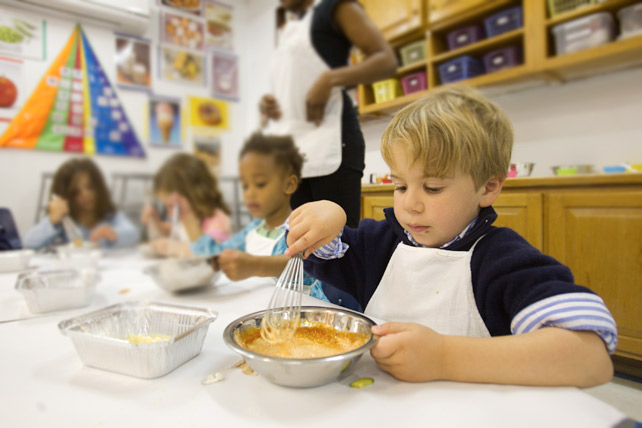Oct
21
2014
Keeping Kids Safe in the Kitchen

SHARED by: Chef Koren, Chef and Educator at Kitchen Little Cooking School
Cooking with children can be an enriching experience for everyone involved. However, dangers in the kitchen are unavoidable and education is a fundamental component to the cooking experience. Here are our tips for keeping kids safe in the kitchen:
- Proper prep – Prep the ingredients and set-up the stage for the cooking experience before you invite a child into the kitchen. This ensures that your focus will be on teaching children the necessary tasks of a recipe. Without the proper prep, you will find yourself multi-tasking which can be dangerous and takes away from the cooking experience.
- Timing – Understand that recipes will take longer because you will first show how to perform a task, then watch and correct as the child perform it themselves. Keep in mind that it doesn’t need to be “perfect.” Cooking with children is more about the process than the final product.
- Dangerous Tools – Have a conversation about the dangerous tools in the kitchen and explain what makes them dangerous. Avoiding this topic makes children curious about certain tools and appliances which can lead to harmful accidents. Explain why you don’t put your hand in a blender. Show them that knives are sharp and are not to be used without adult supervision. Tell them that the stove is hot and can burn them. Do not underestimate the power of repetition here. Review your safety tips before each cooking activity.
- Raw Foods – Using raw foods when cooking with children can pose a problem, as children process information using their “sensory tools.” They often explore new things by putting it in their mouth, which can cause a problem when cooking with raw foods that may carry diseases, such as eggs.
- Hot surfaces – Teach children about hot surfaces and explain to them that the stove can burn them. Always turn pan handles to the left or right to avoid catching and potentially landing on someone. It is best to wait to use the stove until after the children finish “cooking” so you can devote your time to the stove. If you need to keep them engaged, give them a sponge and have them start cleaning the cooking area.
- Chemicals – This may seem obvious, but as a reminder, keep all harmful chemicals locked in a cabinet that is inaccessible from your child. Putting them out of reach is not enough, as they might climb up onto the counter and access it.
- Child-Size Tools – Cooking is a great activity to practice fine motor skills, however adult utensils are often too large for a child to manipulate. Avoid the frustration by getting some basic kitchen utensils made for small hands. You can find a lot of options on Amazon.com.
Remember that children are new to the cooking process and there are many skills that we as adults have learned over time. Be patient, repeat instructions and enjoy!









